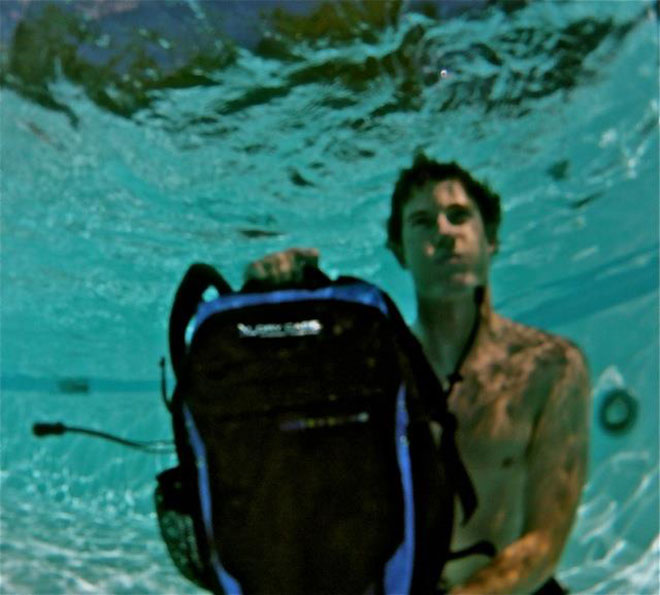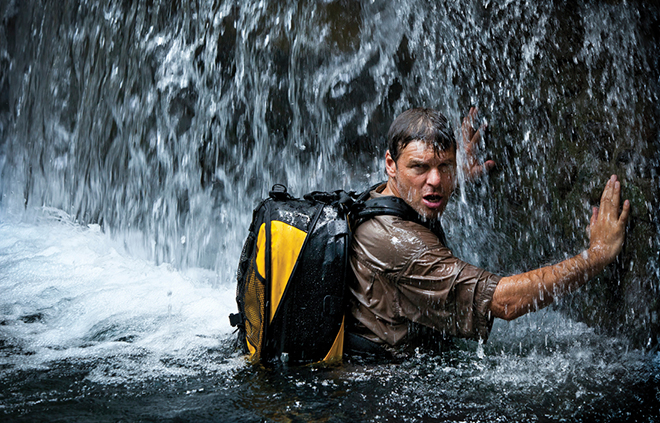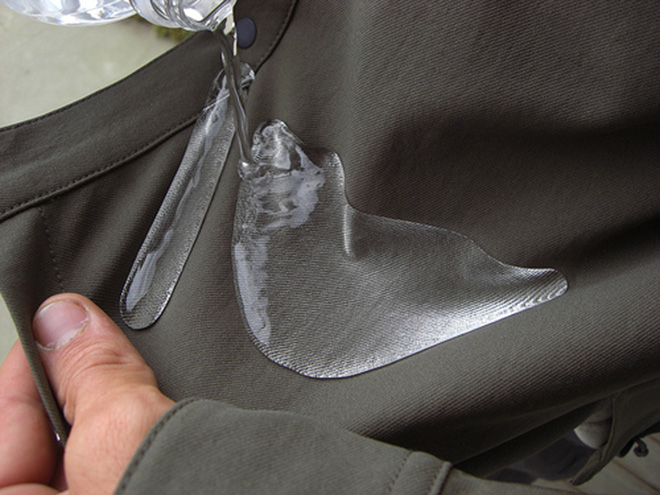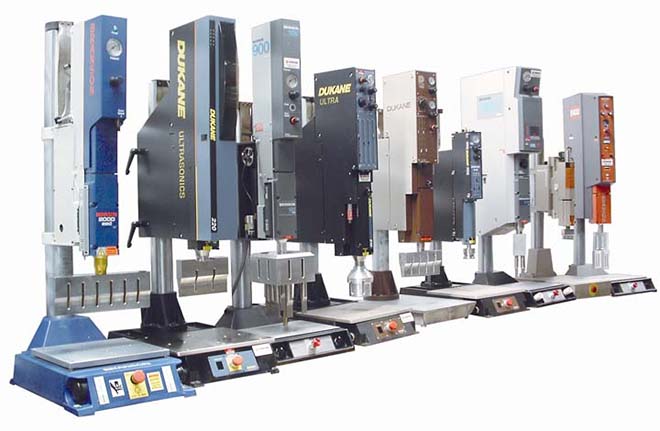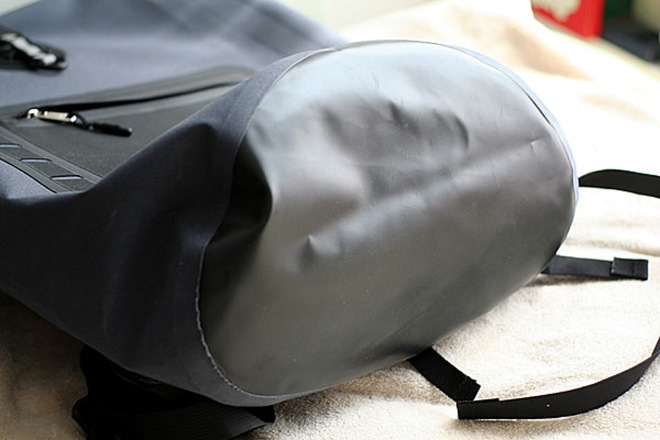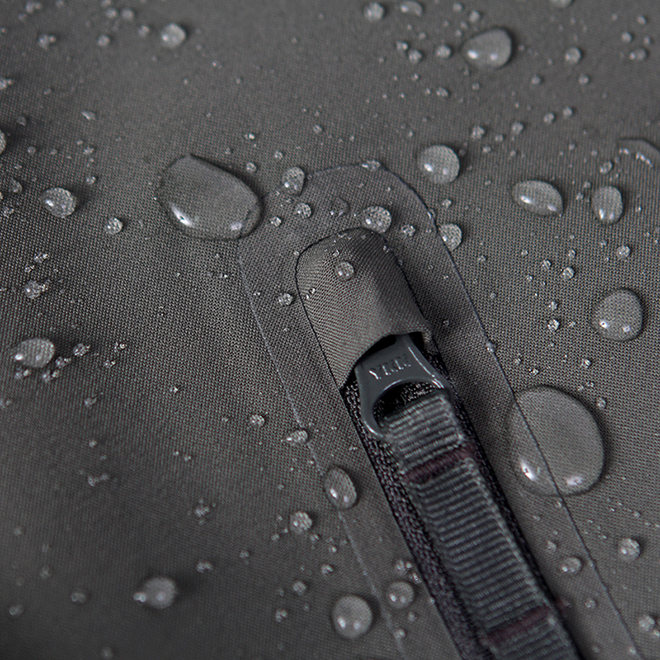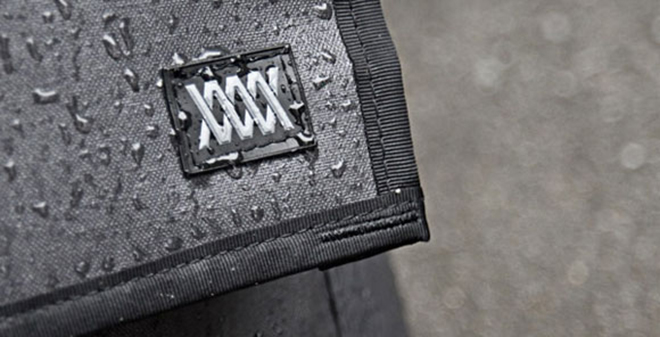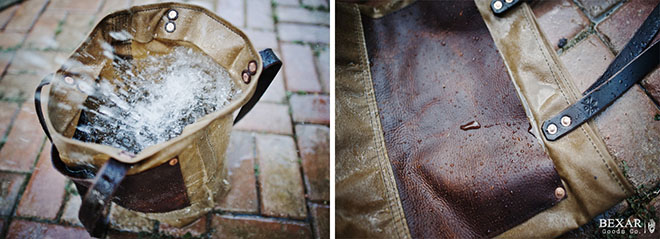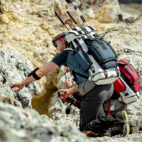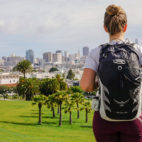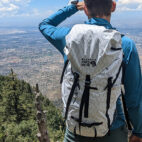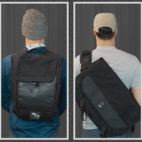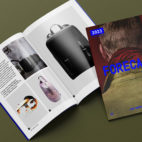Waterproof vs Water-Resistant, explained
I used to think that I needed a waterproof bag…
Why?
Because I did.
Because I had to have one.
My “amazing” adventures and my life demanded it.
The important and expensive things I carried must never ever get wet, never.
I wanted that assurance, that if there were a sudden tropical rainstorm, my tech gear would be perfect, no questions asked, no matter how hard the rain came. Now, with personal experience and via my professional experience…
I’ve realized, this is ridiculous.
Let’s explore the differences between Waterproof and Water-Resistant.
Waterproof means the bag can be submerged completely underwater for long periods of time, and there won’t be one single drop of water that enters the interior. Think of a balloon, completely sealed off from the outside world. You can take a waterproof bag 100 feet underwater on a SCUBA expedition, high five a European Conger Eel, discover and retrieve some hidden pirate treasure, and then once you’re topside 5 hours later, you can open up the waterproof bag and pull out that bone-dry Picasso to admire, that you had tucked away in there with your iPhone 8 (that you then use to set an afternoon date atop of Mount Vernon with the prince of Abu Dhabi’s girlfriend). That, or you’re a legitimate white water X-Games kayaking competitor madman or madwoman who regularly capsizes because you’re constantly pushing the envelope of the extreme.
The process of making a bag 100% waterproof can be achieved a few different ways. But it comes down to three things…
1) materials
2) construction techniques
3) cost
The materials, obviously, have to be 100% waterproof. Pores that are much too microscopically small for water molecules to pass through, zero pores is ideal. Every bit of this material needs to be cut into panels and joined together to achieve the shape of a bag. Think 3D puzzle. If there are stitched holes where these panels meet, it isn’t waterproof. Needle holes mean water can get in. It is a hole after all. Even if they use silicone over those holes, the silicone will eventually de-bond. The most common way of joining these plastic panels together to achieve 100% waterproofness is called Ultrasonic Welding (another info source from HowStuffWorks). This is a difficult and relatively rare construction technique, reserved only for products that absolutely need to be waterproof. The machines are insanely expensive, and they are run by highly skilled technicians. Sewing is an art form. Ultrasonic welding is where art meets science.
Ultrasonic welding is what happens is that the two panel edges are carefully aligned, pressed together, then a machine focuses extremely high levels of ultrasonic sound waves into this seam. The energy from these sound waves is transformed into heat, which permanently bonds the two panels together (usually containing a thermoplastic material), making the two panels into one solid panel, with no holes whatsoever. When the factory messes up, to maintain proper quality control they will toss these mistakes, as if you sell something called waterproof, it has to be waterproof. As you can imagine, this machine is expensive, the technicians that run them are also more expensive than an employee at a sewing machine, and the material itself is more expensive than your traditional synthetic or natural fabrics. So if you really want 100% waterproof, be prepared to pay for it.
Also, be prepared to have a relatively odd-looking bag on your shoulders or at your hip. Since they’re made differently, they appear different. They’re not ugly, but more than likely a 100% waterproof bag would look extremely out of place in a business meeting, and will not go with a suit. As Boreas puts it, “fully waterproof packs are heavy, awkward and uncomfortable.“
Lastly, the access options for these bags are limited. The more handy access points there are, the more risk there is of water entering the bag through these access points. Think of water as an invading enemy army and you’re strategically building a castle for defense. You wouldn’t add 40 entrances. Just one, with a lot of defensive focus on it. This is why these bags usually have roll-top access points, a closure method which is waterproof, as the opening folds over on itself two or more times to seal out water. Or, these bags can use legit waterproof zippers (most of the “waterproof zippers” being used and advertised out there aren’t waterproof, but just water-resistant). Legit waterproof zippers are usually imported, custom made to spec by geniuses, and also very expensive. Some examples of waterproof zippers are TIZIP, RiRi Aquazip, YKK AquaSeal, etc.
Water-resistant is all most of us need. Of course, your backpack has a brand new 23″ MacBook Helium Pro (fully upgraded), a brand new prototype smartphone with all the accessories, your professional grade Nikon DSLR camera w/900mm lens, an iPad 7, a Kindle, and a secret government grade GPS / satellite control module. OK, the stuff inside your backpack could be sold to purchase a small country. You’re on vacation, with your backpack full of the aforementioned tech, walking through the city streets of a foreign country, snapping shots of the local sword-swallower… and across the plaza, you hear a buzzing FM radio, the voice of the radio personality rapidly switching from language to language, warning of a massive typhoon storm quickly approaching. Its on. And your water-resistant backpack just won’t be able to handle this rain.
Here is where that waterproof bag is perfect, right?
No.
Well, not necessarily.
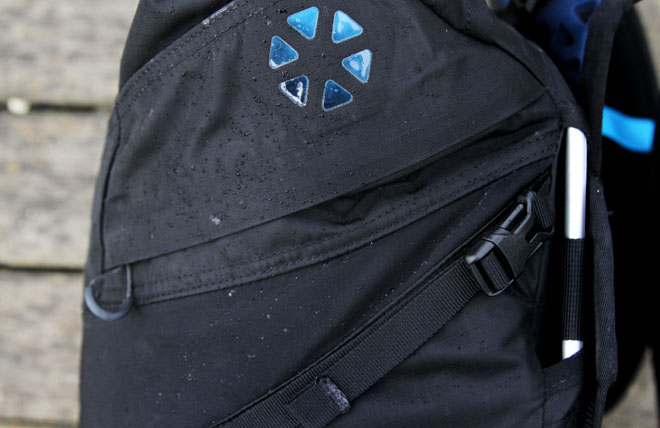
99.999% of you will step a mere 20 inches to your left, and stand under the cover of an awning… or an umbrella… under a tree… or go inside a coffee shop… or back to your hotel room. Literally anywhere. Wait it out. Your gear is expensive, so go inside, don’t stand in the middle of a street in a rainstorm by yourself like a total weirdo. Chances are, when you’re at work and it starts to rain, you don’t leave your office to rush outside, stand there, get soaked, then come back into work once its sunny. We’re all human, we generally avoid extreme downpours. 99.999% of the time.
Now 0.001% of the time, you might be in a tropical setting, on a boat, in the rainforest, etc. This is where you pull out your $30 sil-nylon pack fly raincover and wrap it over your bag. These work great. They pack away super small, and add that additional layer of defense, preventing rain from getting into your bag. Plus, then you get to use your favorite water-resistant bag, whether it’s made from leather, nylon, cotton, synthetics, etc. In all other situations, that would mean its a hurricane or a tsunami coming and you should be worried about saving your life and not about your gear… FEMA will buy you another iPod Nano.
Let’s talk about what water-resistant means. It means the fabrics used generally aren’t 100% waterproof. The most common fabrics are nylon and polyester, which are measured in Denier. Denier is based on a natural standard: a single strand of silk is approximately one denier. So 400D means one of these fibers in a 400D fabric equals roughly 400 pieces of silk thread. 1000D = 1000 pieces of silk thread. Then these fibers are woven together to create the fabric. That is why when you look closely at a 400D fabric, the individual lines (fibers) will be smaller than the individual lines on a 1000D fabric. Even though these fabrics are woven together very tightly, water is still very very small. This means water can pass through the pores where these fibers pass by each other. Sometimes rainfall cannot pass through these tiny pores since raindrops don’t weigh very much, but high water pressure (caused from a pressure washer and/or the pressure from submerging the bag deep under water) will cause water to find its way through.
Many of your traditional synthetic fabrics will include a layer or three of PU, PVC or some sort of soft TPE on the backside of the fabric, to help prevent water from sneaking through the holes between the fibers. This coating is usually sprayed or laminated on by the factory’s fabric supplier, before it gets to the factory cutting room, but sometimes factories have their own coating room (uncommon, but cool when they do). Occasionally a Teflon coating will be applied to the front of the surface of the fabric (Mystery Ranch does this), to help water bead up and roll off the surface. And yes, sometimes the fabrics used in the construction of a water-resistant bag are absolutely 100% waterproof. But if they’re not joined together with a waterproof method of construction, the entire bag won’t be waterproof. And if they are, the zippers need to be real waterproof zippers, not water-resistant zippers, or pretend waterproof zippers which are out there a whole lot.
With standard zippers, the teeth have openings in between them. With rain droplets hitting them from the top these can let small drops of water in. Additionally, you’ll see zipper flap/covers used. These are usually just fabric which covers the zipper’s exposed teeth, a simple barrier to keep rain (which usually falls straight down) from dripping through the teeth which are exposed to this downward falling rain. This is why some companies use these water-resistant zippers or put this fabric flap over the top of the zipper. Water-resistant and waterproof zippers are great, and sure, they can help. But the nicest waterproof zipper won’t keep the inside of a water-resistant bag made from water-resistant (or waterproof) materials, constructed in water-resistant methods, completely dry. The zipper then becomes the only waterproof element; the rest of the bag still has needle holes and is simply water-resistant. It’s kind of like adding one 2″x2″ piece of Kevlar to a tshirt and calling it bulletproof. That 2″x2″ section may be, but the rest, is not.
To be honest, if water-resistant bags and their materials and construction work really well, rain will hardly cut through them like a hot knife through warm butter. During a serious torrential downpour, water will bead up on the outside and on top of the water-resistant fabric. But eventually, after quite a bit of rain, the fabric will become waterlogged and eventually soak up the water. So if piece of paper inside your pack is touching up against the wall of the bag it may become wet. But your bag will not immediately just fill up with 1 gallon of water. Again, where the fabric panels meet each other at the seams, this is where water can sneak in. If you were to slowly lower the bottom half of a standard backpack in a bucket full of water, the bottom stitched seams will allow water to slowly sneak in and fill the bottom of your pack. Water will not rush through the fabrics themselves, it will first sneak in through these seams (or the zippers). This is why some companies use better/more water-resistant bottoms on their packs (be it the material and/or the construction). Some even focus on seam taping, which helps to prevent water from coming in at the seams, but doesn’t make it 100% waterproof.
That being said, water-resistant packs are great. They’re more affordable. They have better/more access points. They’re generally better looking and more comfortable (your opinion may vary). And you have more carry brands/products/options to choose from.
A further useful factor to consider is the IP Code. “Waterproof” and “water-resistant” don’t always mean the same thing in different contexts. However, a product may have an IP rating (also known as an International Protection Rating or Ingress Protection Rating). Such a rating is designed to provide users with more detailed information about a product’s level of protection with regards to the intrusion of water, dust, solid objects and accidental contact. Find out more about the various ratings here.
Watch out for a follow-up post on this discussion, which we’re calling “The Waterproof / Water-Resistant Everyday Reference Guide“.
*Update Oct 2016: Check out our updated: Waterproof vs Water Resistant. What Do I Need? post! We break things down a little simpler and give suggestions on great bags that suit, drizzle, rain, downpours and submersion.
Image credits:
Carryology Waterproof vs Water Resistant 2 (Triple Aught Design)
Carryology Waterproof vs Water Resistant 4 (Mission Workshop)
Carryology Waterproof vs Water Resistant 15 (Bexar Goods)
Contact us for photo credit, as the remaining photos were on an external hard drive we had from months ago.





 Carry Awards
Carry Awards Insights
Insights Liking
Liking Projects
Projects Interviews
Interviews
